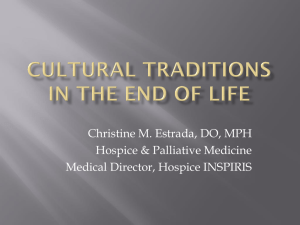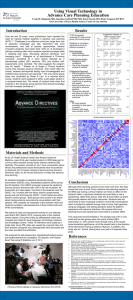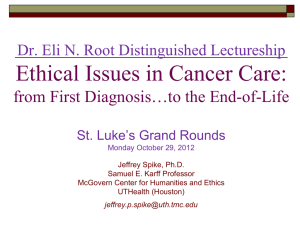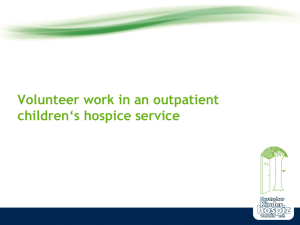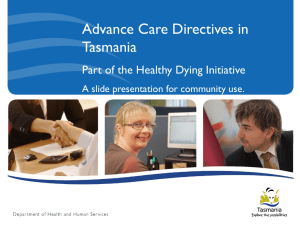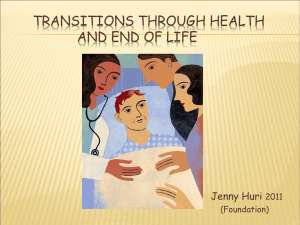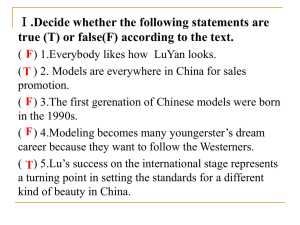Karen Wyatt – What Really Matters
advertisement
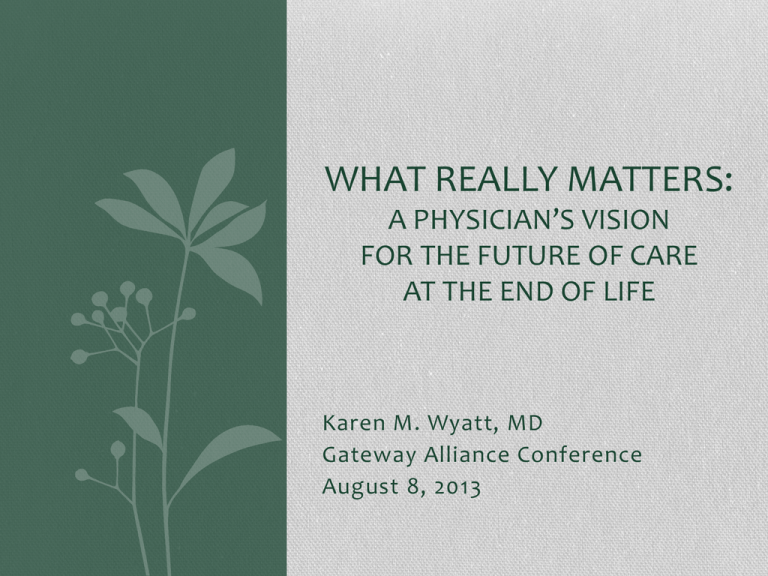
WHAT REALLY MATTERS: A PHYSICIAN’S VISION FOR THE FUTURE OF CARE AT THE END OF LIFE Karen M. Wyatt, MD Gateway Alliance Conference August 8, 2013 DISCLOSURE: I have no actual or potential conflict of interest in relation to this presentation. Karen Wyatt, MD August 8, 2013 Objectives: At the end of the presentation participants will be able to: Identify 4 factors within the Western medical model that create obstacles for physicians in providing effective end-of-life care. Recognize the unique challenges and opportunities for the future of end-oflife care that accompany the aging of the Baby Boom generation. Describe the components of an Integral approach to the end-of-life that can help meet the challenges of the future. Utilize Integral concepts to engage physicians in the creation of a new, shared vision for end-of-life care. Who am I and why am I talking about the end-of-life and spirituality? • Family practice physician • Many years of experience as hospice medical director • Storyteller and writer • Lifelong seeker of spiritual wisdom Workshop Outline: 1. The Current Problem: Difficulty engaging physicians in the end-of-life process results in late referrals and short lengths of stay 2. The Source of the Problem: How the Western medical model creates obstacles for physician engagement in the end-of-life process 3. What the Future Holds: 1. 2. Integral Medicine is coming Baby Boomers are changing everything! 4. A New Vision for End-of-Life Care: How to change our approach and increase engagement with Western medical providers using the Integral model 5. Q&A Difficulty engaging physicians in the end-of-life process creates THE PROBLEM The Problem: Physicians Reluctant to Engage in End-of-life Care – Unmet Needs of Patients 2011 Nebraska End-of-Life Survey Results: “70 percent of patients surveyed want their doctors to discuss their end-of-life care options, yet only 21 percent …had heard about hospice care from a doctor.” http://journalstar.com/links/online-exclusives/nebraska-end-of-life-surveyresults/pdf_f5c93ec4-ce4f-5edb-9b46-5bb975319963.html The Problem: Physicians Reluctant to Engage in End-of-life Care – Good News and Bad News Centers for Disease Control: Good News: “Hospice use at the time of death increased from 21.6% in 2000 to 42.2% in 2009.” Twice as many patients referred! Bad News: “28.4% of those hospice patients referred in 2009 received 3 days or less of hospice care.” Too little care to make an impact. Teno, et al.;JAMA. 2013;309(5):470-477. doi:10.1001/jama.2012.207624. The Problem: Physicians Reluctant to Engage in End-of-life Care – False Hopes Dana-Farber Cancer Institute: Of 1,274 stage IV lung and colon cancer patients in the study who were receiving chemotherapy “69% of the lung cancer patients and 81% of the colon cancer patients did not understand that the chemotherapy they were receiving was not likely to cure their disease.” Weeks, et al.; N Engl J Med 2012; 367:1616-1625 The Problem: Physicians Reluctant to Engage in End-of-Life Care – Missed Opportunities Dana-Farber Cancer Institute: “Terminally ill patients who talk to their doctors about EOL care at least a month before they die are more likely to choose therapy that is less aggressive— therapy aimed more at making them feel better than at prolonging life.” Mack, et al.; J Clin Oncol. 2012 Dec 10;30(35):4387-95 The Problem: Physicians Reluctant to Engage in End-of-life Care – Decreased Survival National Hospice and Palliative Care Organization: “the mean survival was 29 days longer for hospice patients than for non-hospice patients.” ConnorSR, et al. J Pain Symptom Manage. 2007 Mar;33(3):238-46 The Problem: Physicians Reluctant to Engage in End-of-life Care – Diminished Quality of Life Harvard University: “Physicians who are able to remain engaged and ‘present’ for their dying patients – by inviting and answering questions and by treating patients in a way that makes them feel that they matter as fellow human beings – have the capacity to improve a dying patient’s [quality of life].” Zhang B, et al "Factors important to patients' quality of life at the end of life" Arch Intern Med 2012; doi:10.1001/archinternmed.2012.2364. …treating dying patients in a way that makes them feel that they really matter … improves their quality of life … So why do doctors struggle to engage with their patients at the end-of-life? The Western Medical Model has inherent obstacles to embracing the end-of-life and is one SOURCE OF THE PROBLEM How Doctors Learn About Death & Dying Statistics from The National Report on The Status of Medical Education in End-of-Life Care*: • Less than 18% of students and residents surveyed had received formal end-of-life care education • 39% felt unprepared to address patients’ fears about death • Nearly 50% felt unprepared to manage their own feelings about death • 40% felt that dying patients were not considered good teaching cases and that meeting the psychosocial needs of dying patients was not a core competency *Sullivan, et al., J Gen Intern Med. 2003 September, 18(9): 685-695 Obstacles to End-of-Life Care for Western Medical Physicians: 1. The Science of Medicine • • • • Measurable Objective Materialistic Outcome oriented (Focused on “Cure”) Obstacles to End-of-Life Care for Western Medical Physicians: 1. The Science of Medicine • • • • Measurable Objective Materialistic Outcome oriented (Focus on “Cure”) 2. The System of Medicine • • • • • Time limitations Lack of reimbursement Medicare regulations Malpractice litigation Lack of training in medical schools Obstacles to End-of-Life Care for Western Medical Physicians: 1. The Science of Medicine • • • • Measurable Objective Materialistic Outcome oriented (Focus on “Cure”) 3. The Culture of Medicine 2. The System of Medicine • • • • Hierarchical Territorial and fragmented Poor communication between disciplines Unrealistic expectations (“Our job is to sustain life”) • • • • • Time limitations Lack of reimbursement Medicare regulations Malpractice litigation Lack of training in medical schools The “Hidden Curriculum” From the National Report on the Status of Medical Education in Endof-Life Care: “In the clinical arena, students are systemically protected from, or deprived of, opportunities to learn from caring for dying patients. When they do participate in this care, they lack role models with expertise to learn from, as well as feedback and support that facilitate clinical growth.” *Sullivan, et al., J Gen Intern Med. 2003 September, 18(9): 685-695 Obstacles to End-of-Life Care for Western Medical Physicians: 4. Personal Experience 1. The Science of Medicine • • • • • • • Unhealed grief Denial of death Fear of the unknown Measurable Objective Materialistic Outcome oriented (Focus on “Cure”) 3. The Culture of Medicine 2. The System of Medicine • • • • Hierarchical Territorial and fragmented Poor communication between disciplines Unrealistic expectations (“Our job is to sustain life”) • • • • • Time limitations Lack of reimbursement Medicare regulations Malpractice litigation Lack of training in medical schools The Doctor’s Quiet Grief Findings from a study of oncologists at 3 Canadian hospitals: • > 50% struggled with feelings of failure, self-doubt, sadness and powerlessness • Unacknowledged grief led to inattentiveness, impatience, irritability, emotional exhaustion and burnout • 50% distanced themselves and withdrew from patients as they got closer to dying • 50% reported unhealed grief altered their treatment decisions with subsequent patients (resulting in more aggressive treatment and reluctance to recommend palliative care or hospice) Arch Intern Med. 2012;172(12):964-966. Negative Attitudes About Death and Dying: 4. Personal Experience 1. The Science of Medicine “Death is an unacceptable outcome.” 3. The Culture of Medicine 2. The System of Medicine Negative Attitudes About Death and Dying: 4. Personal Experience 1. The Science of Medicine “Death is an unacceptable outcome” 3. The Culture of Medicine 2. The System of Medicine “Death and dying are not important” Negative Attitudes About Death and Dying: 4. Personal Experience 1. The Science of Medicine “Death is an unacceptable outcome” 3. The Culture of Medicine 2. The System of Medicine “Death is a failure” “Death and dying are not important” Negative Attitudes About Death and Dying: 4. Personal Experience “Dying is a hopeless tragedy” 1. The Science of Medicine “Death is an unacceptable outcome” 3. The Culture of Medicine 2. The System of Medicine “Death is a failure” “Death and dying are not important” WHAT DOCTORS NEED TO LEARN ABOUT DEATH AND DYING What Doctors Need to Learn About Death & Dying 1. Death is inevitable 2. Death is a mystery. 3. Death makes life more precious. 4. Dying provides an opportunity for transformation. WHAT THE FUTURE HOLDS – PART 1 “Integral Medicine” is on the horizon What is “Integral Medicine?” • Based on the work of Ken Wilber • “Integral” comes from the Latin word for “whole” • Provides a comprehensive map for analyzing a patient, an illness, a problem or a system from multiple perspectives The 4 Perspectives of Integral Medicine: Emotional/Spiritual Physical Culture & Community Social Systems Obstacles for Physicians in Western Medicine to End-of-Life Care: 4. Personal Experience 1. The Science of Medicine 3. The Culture of Medicine 2. The System of Medicine The 4 Perspectives of Integral Theory Applied to End-of-Life Care Issues for MD’s: Emotional/Spiritual Physical 4. Personal Experience 1. The Science of Medicine Culture & Community Social Systems 3. The Culture of Medicine 2. The System of Medicine The 4 Perspectives of Integral Medicine Emotional/Spiritual Physical • Physical exam • Diagnostic tests • Medication • Surgery Culture & Community Social Systems The 4 Perspectives of Integral Medicine Emotional/Spiritual Physical • Physical exam • Diagnostic tests • Medication • Surgery Culture & Community Social Systems • Living situation • Economic factors • Insurance • Healthcare policies • Social delivery system The 4 Perspectives of Integral Medicine Emotional/Spiritual Physical • Physical exam • Diagnostic tests • Medication • Surgery Culture & Community • • • • Relationships Group values Cultural beliefs Meaning of illness Social Systems • Living situation • Economic factors • Insurance • Healthcare policies • Social delivery system The 4 Perspectives of Integral Medicine Emotional/Spiritual Physical • Emotions • Psychological attitudes • Spiritual Practice • Intentions • Physical exam • Diagnostic tests • Medication • Surgery Culture & Community Social Systems • • • • Relationships Group values Cultural beliefs Meaning of illness • Living situation • Economic factors • Insurance • Healthcare policies • Social delivery system The Characteristics of Integral Medicine • • • • • • • Comprehensive Balanced Interdisciplinary Multiple perspectives Team approach Individualized care Whole-person care Western Medicine is Out of Balance Emotional and Spiritual Physical Cultural Social Systems Integral Medicine v. Western Medicine Integral Medicine Characteristics: Whole-person care Individualized Balanced Interdisciplinary Team approach Comprehensive Western Medicine Characteristics: Organ System-focused Standardized Predominantly Physical Specialized Fragmented Partial Integral Medicine and Hospice Care Integral Medicine Characteristics: Whole-person care Individualized Balanced Interdisciplinary Team approach Comprehensive Hospice Care Characteristics: ✔ ✔ ✔ ✔ ✔ ✔ Hospice Care is Balanced and Integral Emotional/Spiritual • Physical • Chaplains Mental Health Care Providers • Grief Counseling • Spiritual Support • Nurses • Home Health Aides • Medical Providers • Symptom Relief • Comfort and Dignity Culture & Community • Volunteers • Community Outreach • Relationships • Family Support Social Systems • • Social Workers • Insurance • Medicare Benefit In-home or Inpatient Facility WHAT THE FUTURE HOLDS – PART 2 78 million Baby Boomers are approaching the last stages of life The Baby Boom “Tsunami” “For the next 18 years, one American will turn 60 years old every seven seconds.” “Every day 10,000 Baby Boomers become eligible for Medicare.” Characteristics of the Baby Boom Generation: • More likely to be college graduates than previous generations • Independent and self-reliant • Youthful mindset • 20% of women are childless (double the previous generation) Characteristics of the Baby Boom Generation: • Savvy, discerning consumers • Focused on longevity • Interested in fitness and wellness • Demand choice How do Baby Boomers differ from their parents? Traditional Generation Values: Conformity Following the rules Respect for authority Hierarchy Past-oriented Baby-Boom Generation Values: How do Baby Boomers differ from their parents? Traditional Generation Values: Baby-Boom Generation Values: Conformity Following the rules Respect for authority Hierarchy Past-oriented Independence Individual choice Self-actualization Team approach Goal-oriented How Baby Boomers are Changing the Culture of Medicine: • Demand information and choices • Demand convenience • Do research on the internet - 74% use the internet daily (according to Pew Research Center) and 78% of users seek out health information online • Comparison shopping – use online reviews and ratings to choose doctors and medical facilities • Communicate and network with other patients What needs to change? Culture of Medicine Values: Hierarchical Authoritarian Territorial Lack of communication Traditional Generation: ✔ ✔ ✔ ✔ Baby Boomer Generation: ✖ ✖ ✖ ✖ How Doctors are Reacting to Change: According to a survey by Deloitte Center for Health Solutions: 60% of physicians surveyed “said they expect many of their colleagues to retire earlier than planned in the next 1 to 3 years.” BUT they may not be able to retire: “Seventy-five percent of Americans nearing retirement age in 2010 had less than $30,000 in their retirement accounts.” - Teresa Ghilarducci, Professor of economics at New School for Social Research Integral Medicine and Hospice Care Integral Medicine Characteristics: Whole-person care Individualized Balanced Interdisciplinary Team approach Comprehensive Hospice Care Characteristics: ✔ ✔ ✔ ✔ ✔ ✔ Integral Medicine and Hospice Care are Perfect for Baby Boomers: What Baby Boomers Want: Whole-person care Individualized Balanced Interdisciplinary Team approach Comprehensive Integral Medicine Hospice Care Characteristics: Characteristics: ✔ ✔ ✔ ✔ ✔ ✔ ✔ ✔ ✔ ✔ ✔ ✔ Challenges for Hospice in the “Baby Boom Tsunami” • Increased patient numbers • Increased demand for information and transparency • Increased divorce rate among boomers resulting in more complicated family structures and issues to deal with • Less interest in organized religion and more interest in “spirituality” • Increased demand for alternative care modalities • Increased number of single and/or childless patients • Possible increased demand for physician-assisted suicide Opportunities for Hospice in the “Baby Boom Tsunami” • Increased patient numbers • Likely to demand a rational, patient-centered approach to end of life care • Preference for “natural death” • Desire to “Age in Place” • Likely to choose “quality” of days over “quantity” Opportunity • The greatest opportunity for the hospice and palliative movement in the coming “Baby Boom Tsunami” lies in the demand for change in the culture of Western medicine. The movement should step up to provide leadership and expertise in the evolution of Western medicine toward patient-centered, integral care. How to achieve A NEW VISION FOR END-OF-LIFE CARE A New Vision: • Any new vision of end-of-life care must include greater involvement from physicians of every specialty … and the hospice movement must learn how to create and share that vision. Obstacles to End-of-Life Care for Western Medical Physicians: 4. Personal Experience 1. The Science of Medicine • • • • • • • Unhealed grief Denial of death Fear of the unknown Measurable Objective Materialistic Outcome oriented (Focus on “Cure”) 3. The Culture of Medicine 2. The System of Medicine • • • • Hierarchical Territorial and fragmented Poor communication between disciplines Unrealistic expectations (“Our job is to sustain life”) • • • • • Time limitations Lack of reimbursement Medicare regulations Malpractice litigation Lack of training in medical schools How to Engage Doctors in End-of-Life Care Obstacle: Solution: 1. The Science of Medicine • • • • Measurable • Objective Materialistic Outcome oriented (Focused on “Cure”) • Offer scientific studies that show the value of hospice and palliative care and patient preferences for endof-life* Offer training in pain management *Find a Bibliography of End-of-Life studies and articles on my website at http://www.karenwyattmd.com/end-of-life How to Engage Doctors in End-of-Life Care Obstacle: Solution: 2. The System of Medicine • • • • • Time limitations Lack of reimbursement Medicare regulations Malpractice litigation Lack of training in medical schools • Provide patient education materials and resources on end-of-life care* • Offer to evaluate patients for appropriateness for admission • Offer trainings for office staff on dealing with terminal patients, grief *Find a list of resources on my website at http://www.karenwyattmd.com/end-of-life Online Resources for End-of-Life Issues • The Conversation Project: offers a conversation “Starter Kit” to encourage families to discuss end-of-life issues. http://theconversationproject.org/ • Aging With Dignity: Five Wishes – a questionnaire that allows patients to record their medical, personal, emotional, and spiritual wishes for the end-of-life; can be used as an advanced directive http://www.agingwithdignity.org/ • BE Ready: Checklist for End-of-Life Planning http://www.karenwyattmd.com/end-of-life • What Really Matters Radio Show: Lessons from the End-of-Life http://whatreallymatters.srbroadcasting.com/ • End-of-Life University Interview Series: Free interviews with experts about end-of-life issues http://eoluniversity.com How to Engage Doctors in End-of-Life Care Obstacle: Solution: 3. The Culture of Medicine • • • • Hierarchical Territorial and fragmented Poor communication between disciplines Unrealistic expectations (“Our job is to sustain life”) • Offer rotations in hospice care for medical students • Provide CME lectures for medical providers on end-oflife issues and baby boomers • Offer “Lunch and Learn” lectures for residents and interns about end-of-life issues • Start a monthly “Death Café” discussion group How to Engage Doctors in End-of-Life Care Obstacle: 4. Personal Experience Solution: • • • • Provide grief support for hospital and medical staffs • Offer annual memorial service for all patients who have died • Tell stories of hospice patients and their families • Encourage hospitals to create “Death Rounds” to discuss difficult patient deaths Unhealed grief Denial of death Fear of the unknown Transform the Negative Attitudes: 4. Personal Experience “Dying is a hopeless tragedy” 1. The Science of Medicine “Death is an unacceptable outcome” 3. The Culture of Medicine 2. The System of Medicine “Death is a failure” “Death and dying are not important” Transform the Negative Attitudes: 4. Personal Experience “Dying is a hopeless tragedy” 1. The Science of Medicine “Death is an unacceptable outcome” Death is inevitable” 3. The Culture of Medicine 2. The System of Medicine “Death is a failure” “Death and dying are not important” Transform the Negative Attitudes: 4. Personal Experience “Dying is a hopeless tragedy” 1. The Science of Medicine “Death is an unacceptable outcome” Death is inevitable” 3. The Culture of Medicine 2. The System of Medicine “Death is a failure” “Death and dying are not important” “Death makes life more precious” Transform the Negative Attitudes: 4. Personal Experience “Dying is a hopeless tragedy” 1. The Science of Medicine “Death is an unacceptable outcome” Death is inevitable” 3. The Culture of Medicine 2. The System of Medicine “Death is a failure” “Death and dying are not important” “Death is a mystery” “Death makes life more precious” Transform the Negative Attitudes: 4. Personal Experience “Dying is a hopeless tragedy” 1. The Science of Medicine “Death is an unacceptable outcome” “Dying provides an Death is inevitable” opportunity for transformation” 3. The Culture of Medicine 2. The System of Medicine “Death is a failure” “Death and dying are not important” “Death is a mystery” “Death makes life more precious” End of Life Transformation • Love • Forgiveness • Living fully in every moment • Meaning and purpose The “New Vision” for End-of-Life Care: 4. Death and the dying process are valued and revered as transformative teachers of sacred life wisdom. 1. All patients have the opportunity 3. Care is provided in a seamless continuum from diagnosis to treatment to palliation to hospice, by a collaborative team with a shared goal. 2. The last 6 months of a person’s life are considered as important as the first 6 months and this is reflected in medical education and social policies. to have suffering relieved and dignity maintained while receiving whatever level of care they desire at the end-of-life. It’s up to us … … to lead the way! To teach the world that you must hold Life and Death in the same hand … For… Life is not possible without Death To live in this world you must be able to do three things: to love what is mortal; to hold it against your bones knowing your own life depends on it; and when the time comes to let it go, to let it go. From: In Blackwater Woods By Mary Oliver QUESTIONS OR COMMENTS? End-of-Life University • FREE series of online interviews • Targeted for the general public • 3 audio interviews per day X 4 days during Hospice Awareness Month Connect With Me! Sign up for my newsletter at: www.karenwyattmd.com Go to www.karenwyattmd.com/end-of-life to download EOL Resource List and Bibliography Email me: karen@karenwyattmd.com Tune in to What Really Matters Radio Show Archives: http://whatreallymatters.srbroadcasting.com End-of-Life University: Nov. 11-14, 2013: www.eoluniversity.com Facebook: https://www.facebook.com/karenwyattmd Twitter: @spiritualmd Thank you for this opportunity to share stories and thoughts with you! May you be blessed in your healing work! KAREN WYATT MD Email address: karen@karenwyattmd.com Website: www.karenwyattmd.com

